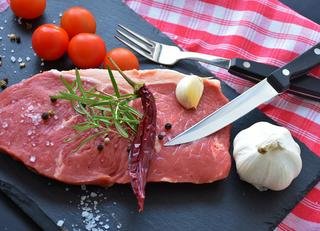Flavor Perfection & Co. Are Challenging the Very First Fermentation Amendment

Do you know how fermentation works? If not, you aren’t alone. Lately, an increasing number of people does know though. 30% of all food eaten worldwide is fermented, so chances are that there’s a fermento inside you, too. As fermentation is taking the world by storm, this number is on the surge. After all, fermented foods do come with a long list of benefits. It’s not only that they are made to last. They also produce a myriad of interesting flavors. Dry-aged beef found its crowd of beef cravers: dig deep into their pockets comes with feeling special. Kombucha keeps popping up wherever you go - from DESIGNATED SURVIVORS to Amsterdam microbreweries. But health-enthuiastic Alkaliners don’t quite join into the frenzy: “While there are good probiotic benefits to Kombucha, the fermentation process, just like alcohol, is HIGHLY acidifying to your body,” says Tracey Osborne from AlkaMind. And with that, they got a jar rolling, that isn’t so crystal clear. THE FERMENTOMAG calls for transparency! Wasn’t fermented food the old-and-new non-plus-ultra? Let’s see what comes to light, when fermented tea and meat turn into a suspects for contradicting themselves.

By Pixabay.
The wisdom of food preservation through fermentation has been cherished for millenia. It’s a natural phenomenon that makes things last and ensures that nothing goes to waste. It also made our ancestors last. They were able to store foods in man-made holes and dig them out once needed. To the survivors!
How rewarding making your own food and knowing what you eat can be, is experienced best as a curious DIYer. When you start fermenting your very own (and some bacterial fellows) creation, you may starting to enjoy. “Good things take time” can go under contemporary meditation techniques. Up for it?
You know that I know that you right now, right here fancy some explosively stinky sardines, disgustingly sticky natto soybeans or blue cheese. Nope? As beauty lies in the eye of the beholder, the sensation of taste is with your palate. As fermentation produces the most original flavors without any limit to their range, some of us have already fallen for fermento classics like a refreshing beer in summer or mouthwatering gherkins on a tasty burger. And others have stepped up the game and moved on to a rather exquisite fermented delicacy: dry-aged beef. Does it go well with kombucha? Worth a try. A good time to scrutinize our accused and beloved: “Prisoners at the bar!”
The Good Part: Beefy, Bitter and One-of-a-Kind
Dry-aged beef and kombucha addicts belong to the folks who intimately know how fermentation works. ‘Dry-aging’ is the maturing of meat. Drying takes out the water of the meat, while microbes ferment their way towards tenderness and flavor in time. So dry-aged beef is not fermented food in the classical sense, but fermentation is what ultimately makes it the mouthwatering menu item it is today. Kombucha entices with a far easier production process than it’s juicy counterpart from the meat section. And it does assert its right to bitter taste - fully. But what exactly is it that makes gourmands and barbecuers alike so desperately fall for fermented beef and tea?
The History of Evidence

Google the 17th century Rembrandt painting ‘THE SLAUGHTERED OX. Back then, dry-aged beef used to be as unattractive as a piece of hanging carcass can be, which was extremely time-consuming to end up on an expensive restaurant menu in first place. With its eye-roller of a name and its pain-in-the-of-a-labor process, the traditional craft behind it just had to give in to a serious image problem. Michael Buhagiar from San Francisco steak house HARRIS’ RESTAURANT recalls perfectly, how people told him that he wouldn’t make it with dry-aged. The future didn’t look bright. Turbid Kombucha on the other hand, seemed to have its marketing strategy together: Ancient Chinese called it THE TEA OF IMMORTALITY already in 221 BC. So our suspects started out from opposite directions. One got off the wrong, the other got off the right foot.
Geeky Beef, Beefy Geek

When Rembrandt colorfully captured hanging meat in the 17th century, he was one of only few who paid tribute to an art through art. It took a painter to honor the maturing of meat. Back then, maturing was the common method for preserving meat. No wonder it didn’t go down as the sleekest thing of the season, but as the seasoned out-of-season item instead.
“The process, by which butchers age beef carcasses in a low temperature, high humidity room for weeks, was hopelessly out of vogue in 1984.”
But as economy tells us: when something becomes rare, its value roars out loud: “Because I’m worth it.” Self-confidence is sexy, the food industry revolution made our dry-aged a jaw-dropping must-have, one that can’t be had from your jar-swapping DIY friends nextdoors. And what about the cup of kombucha in the meantime? The tea time never went out of fashion, tea timers from China over Russia to Germany accredited tremendous health benefits to it, so all good in kombucha land. Accolades came coming in: antibiotic, antiviral, antifungal, stress-relieving, shampoo-replacing, cancer-treating, skin problem-solving and so forthward.
Pretty Thing, But Complicated as Spell

If dry-aged beef looks pretty, lies in the eye of the buyer. “It’s beautiful from the inside,” I hear the defense say. Maybe because he science behind dry-aged beef is deep and complex, from soup to nuts. Starting off, you’ll need to locate the best meat you can get, be it from Ireland, Canada, Italy or elsewhere. But getting it is one thing, keeping it another. When putting meat on a cool room’s wood, hook or a metal rack, you’ll have to tiptoe the thin line of food safety between heaven (fermented-flavorful) and hell (rotten-disgusting). As beef can be contaminated with dangerous bacteria during the maturing process, temperatures need to be kept stable.
“Any colder than 33 degrees and the biochemical process stops working; any warmer than 38 degrees and it will likely spoil.”
Meat ages and dries best when humidity is between 60 and 80 percent, with constantly circulating air. Going to extremes is an option, if you ask David Burke’s Chicago Primehouse. Aiming for perfection in Chicago means adding some layers of complexity: Here, the dry-aging room even gets reinvented: extras like the use of UV light, 800-year old Himalayan salt tiling for air purification plus special seasoning bizarrely sound like a luxury hotel for beef.
Maturing beef takes precision on any level and a great deal of time. We are talking about typically 28-56 days, or atypically up to 15 years. What you want is naturally occurring (good) bacteria in the meat to flourish exactly how you want them to, and keep external (bad) bacteria from growing. The good ones break down the muscle fibers connecting collagen and as a result, the beef’s water will evaporate. By shrinking up to 30 percent as a result, the meat becomes more tender, while flavor and color intensify. When the bark develops a dark Rembrandt-like reddish brown on the outside, it gets shrinked once again: this time it’s the butcher’s knife which does the trimming, just before the meat is cut into steaks.
“Through the aging process, the beef develops a tangy, earthy scent—somewhat like buttered popcorn—a different sheen and a smooth texture. Flavors become more concentrated, beefier.”
So no wonder that dry-aged beef doesn’t come cheap: When you bite into a sizzling $36.34 up to $79 dry-aged 8-to-18 ounces steak, guess what your mouthful is worth! After all, up to 40% of the original cow gets lost on the journey. But three decades on, the San Francisco steak house Harris’ Restaurant is still dry-aging. Having defied its critics with its success story, it’s as if gastronomers and Michelin-star chefs today wanted to outright add something in their own right to prove the critics wrong: The race for the oldest, the most delicious and the most tender dry-aged beef is in full swing. How come?
Almost forgot that we are in court, and kombucha is there, too. Unlike our seasoned beef, kombucha simply is made by fermenting tea and sugar with the kombucha culture. This living health drink is said to taste like something between sparkling apple cider and champagne. Black tea, Oolong tea, green tea and white are all an option. So less wondering about kombucha if it also could be a troublemaker.
Beef Learned to Be Special, In a Good Way
Things have changed - completely. Mass production and mass marketing came along. The high price of our beef has found its audience: expensive now equals exclusive. It’s a well-off and educated audience from Tokyo to Dubai that finds itself attracted to the dry-aged beef crave.
“In today’s food world, guests are more educated than ever,” - David Laxer (president and proprietor of Florida Bern’s Steak House)
Thanks to innovators such as the Scandinavian restaurant Noma, fermented foods put on a new dress, and thus became presentable to the luxury gastro-segment. Dry-aged beef has long been a secret deal maker on Wall Street - and who knows - maybe a stealthy relationship savior as an ‘accompaniment’. This is the sort of crowd which is responsible for its slowly maturing rise from the bottom to the top of menus. They were the ones who first considered dry-aged beef a genuine masterpiece of curing, and happily making room in their capacious wallets.
“You have to take into account that many guests in steak houses are on business accounts and are entertaining clients. So they have a larger discretionary budget.” - Cliff Bramble (co-owner of Kevin Rathbun Steak)
But dry-aged beef also pleases another fanbase of flavor addicts: the parallel universe of the mainstream. We see more hobby cooks and grill lovers not only upgrade to smart grills, but increasingly reach for dry-aged labels in supermarkets - even though those may be fake sometimes, as seen in Japan. After all, streaming chef expertise on Netflix now is just the touch of a button away. Despite of surging beef prices, the exploding Salami trend may have become a silent, but powerful ally to dry-aged beef: all food safety concerns are gone, and with it the inhibitions for holding back funds. The mainstream budgets echo the more brimming ones: only the best products are good enough, no matter what it takes.
“And once people eat dry-aged beef, it ruins anything else for them.”- Larry McGuire (managing partner of McGuire Moorman Hospitality)
Popularity doesn’t automatically translate into profit, though. As per Jon Weber from the San Diego Cowboy Star Restaurant and Butcher Shop, dry-aged beef typically performs about 8 percent less in terms of profit margin compared to the restaurant’s other beef programs. So the attention grabber called for either product or perception improvement.
“We lose a minimum of 40 percent (though the standard is less) to start; the longer we age, the more we lose,” Gresh says. “We price accordingly to keep our food costs in line around 32 percent overall.”
More sophisticated selling techniques became the answer to people who bark, but still will buy. The previously image-battered dry-aged got upgraded to a ‘taste revolution’. The art of the upsell grabbed the hand of ‘The Art of Fermentation’, and worked its flirting technique with the mainstream: Smart menu maneuvering, so that selling side dishes makes dry-aged beef worth serving, and waiters suggesting lower food cost sides such as potatoes, sauces, onion rings, spinach etc. as steak ‘accompaniments’, priced between $3 and $7.50 per item.
“Oh, dry-aging is definitely gaining in strength,” Buhagiar says. “It just sounds better as a selling point.” - Kevin Rathbun Steak
Accompaniments don’t flatter the luxury segment, here the concept is the magic ingredient. Bonein or boneless, it has to look dramatic on the plate. And a lot of drama has to go into it as well. While aiming for the dry-aged beef to be untouched and let it speak for itself, lately some considerable thought goes into sides and seasoning. Quality overrides quantity: Most of the top US steak houses add as little as some salt and pepper, and no more than a scent of garlic, butter or olive oil. But some do go the extra mile. At Kevin Rathbun Steak in Atlanta, where salt is used for dry-aged beef seasoning, the salt comes with its own homemade flavor: daily-blended kosher salt with fresh parsley, sage, thyme, garlic and pepper, and oven-dried on top of that. And here it is where the hunger for perfection has elevated the dry-aged beef to an artisan sensation - back to its roots, the craft, but taken to the next level.
Another major factor that has propelled the revival of a lost art must be the ongoing trend of fermenting foods. Its icon, Sandor Katz, author of ‘The Art of Fermentation’ is basically all over the news: Youtube, The Economist, The New York Times and his own forum (www.wildfermentation.com). His followers call fermentation a lifestyle in search of independence from the food industry protocol. The timing seems just right: In times of Jeff Potter’s ‘Cooking for Geeks’ and Simon Sinek’s ’Find your Why’, people crave for the story looming behind. Looking at ‘Supersize Me’ and all the food that represents the idea of unhealthy food, the dry-aged beef had to become a sophisticated art worth all the time and delicate care, while it is becoming an ever starker contrast to the conventional (or former) perception of beef. Dry-aged beef has decided to make flavor perfection its ultimate purpose, and with that it answered to the Why. Would Rembrandt, too, buy? The power of perception won.
“Dry-aging was sort of a lost art,” says Rick Gresh, former executive chef at David Burke’s Primehouse in Chicago. “But as people have explored pickling, canning and going back to the way things were done years ago, they’ve rediscovered dry aged meats.”
Fastforwarding the Production Game
Up until the 1970’s, meat had been dry-aged. Vacuum packaging technology sent the food industry on a new course: the era of wet-aged beef. Happy meatpackers witnessed meat aging faster while retaining more water weight translating into more profit. Thanks to the advancement of technical engineered cooling systems, food safety risks were minimized. So the traditional meat hanging method made space for the food industry revolution: In the world of ‘more, faster, better’ there was no place for the good old dry-aged beef. But vintage being vintage, it always is good for a comeback: dry-aged beef is having its moment.
And kombucha? Never stopped having its moment, always was on the sunny side of things. No compromising moisture, no losing its fresh looks.
Same Boat, But Different Destination
What goes unnoticed in the wave of attention both dry-aged beef and kombucha have been getting is, that the original concept of fermentation was about preserving, about making things last, stretching resources and letting nothing go to waste. Only later on, the huge plus of flavor perfection was added. The backbone of fermentation benefits now is wrestling with a newcomer: Up to 40% of that original beef is lost in the process, while piece by piece is cut off for the sake of perfection. The nothing-go-to-waste credo literally went to waste.
Our dry-aged beef whispers it secretly on its own, dramatic (Even in the 17th century the painter Rembrandt captured this theme in his painting THE SLAUGHTERED OX. A cut open ox is hanging in a dark butchers chamber, the red meat is marbled with yellow fat. In the background, we see the curious stare of the butcher’s wife zoom in on the pic.) as it’s presented on the plate, being crowned as “the sweetest and juiciest” beef in the world and praised with features like ‘substantial fat cap’ and ‘superior marbling’:
“Fermentation and I used to be friends. Now it feels like we are set up against each other like two boxers in the ring: nothing-go-to-waste versus flavor perfection. Sad story.“
The further fanatics push the boundaries, the more they extend the aging time for the ultimate flavor experience, the more cow gets lost on the way - and the thinner gets the line: are we still fermenting, or already rotting? Is the hunger for perfection still healthy, or have our desires become rotten? Contradictory often promises to be interesting. Dry-aged beef is no different. It lends itself perfectly as a temptation: both to a meat lover’s dinner and drama. Maturing will show, if we survive the intense aging process without drying out. Will the contradiction result in wine, that gets better the older it turns, or will its contradiction outdate itself?
And kombucha? If you ask AlkaMind, kombucha comes with alcohol. Has it been blurring our senses? Is it really true that the “acidifying” x factor beats all the physical and mental health benefits reconfirmed over millenia? If you are not sure, just make a Tee from tea, just like Suzanne Lee. If you are looking to take sides, kombucha’s defense is all over the Internet, but its prosecutor is right down here.
Dry-Aged Beef is Bonnie, Kombucha is Clyde

AlkaMind finds kumbucha guilty as charged. But after all, it’s your cup of tea.
Hi Martina,
Great question. Fermentation is a metabolic process that converts sugar to acids, gases, and alcohol, and occurs with yeast and bacteria.
For example, Kombucha. It's a very popular fermented drink, but it's not really the best. Here's an article about that: http://www.getoffyouracid.com/drink-good-kombucha-youre-drinking-alcohol/
It is made by the process of fermentation which is created by the decay from bacteria. Because its fermented, it is filled with sugar and yeast and bacteria and end result is ALCOHOL! In fact, Kombucha is under fire and a lot of scrutiny right now because of the fermentation, many of these drinks are over the legal amount of alcohol of .08.
When you are dealing with cancer, it is imperative to avoid anything that has sugar, grains, or any form of yeast or fungus (fermentation of sugar in Kombucha is filled with yeast).
While there are good probiotic benefits to Kombucha, the fermentation process, just like alcohol, is HIGHLY ACIDIFYING to your body. This is why it is unhealthy to have moderate to high level sugary fruits by themselves (without a healthy fat) as it undergoes this same process of fermentation, creates acid and alcohol in your body.
In fact, because of the creation of alcohol, Kombucha drinks are under strict supervision by the Alcohol and Tobacco Tax and Trade Bureau, who monitors beverages that have more that .5% alcohol content in it to be classified as alcoholic. If you are looking for probiotic, which is very important, I suggest you take a probiotic supplement.
Make sure it is one that has to be refrigerated. It is also important to rotate your probiotic supplement every 30 days, because there are many different strains of probiotic, and your gut flora will get used to the one kind. I alternate between Innate Choice and Klare Labs, but there are a bunch of good ones out there. If you are interested in reading the article on Kombucha and alcohol that I was referring to, here is the link.
I hope that helps.
Have a wonderful day,
Tracey Osborne
AlkaMind Customer Support
Content by Martina Hollweck.


Welcome to Steem Community @martina.hollweck! As a gentle reminder, please keep your master password safe. The best practise is to use your private posting key to login to Steemit when posting; and the private active key for wallet related transactions.
In the New Steemians project, we help new members of steem by education and resteeeming their articles. Get your articles resteemed too for maximum exposure. You can learn more about it here: https://steemit.com/introduceyourself/@gaman/new-steemians-project-launch